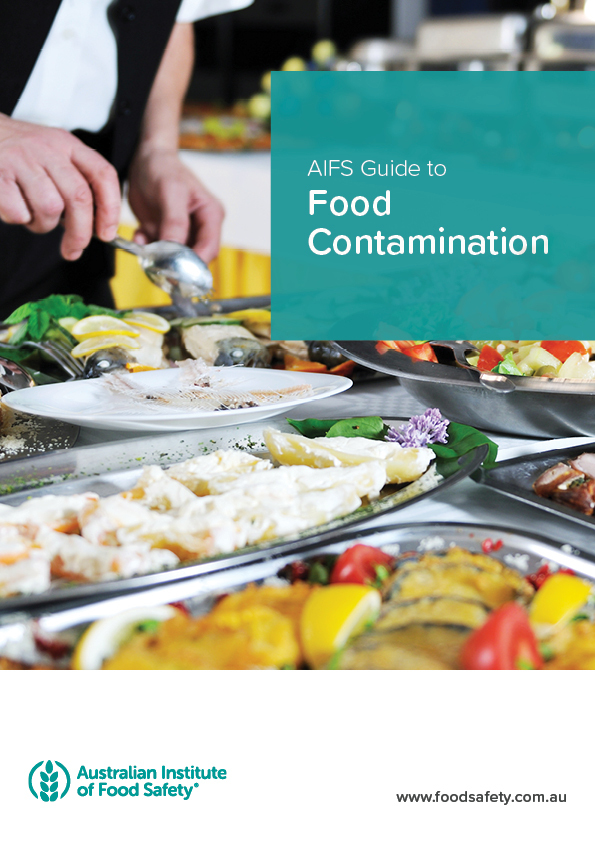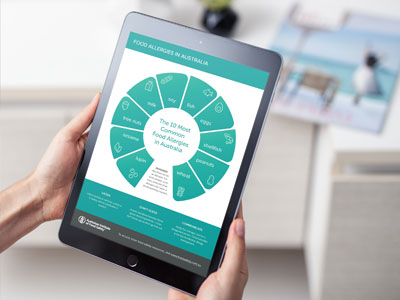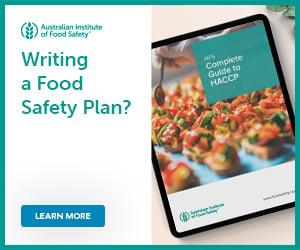
If you own, manage or work at a food establishment, it is important to understand what the potential food safety hazards and risks are, this includes being aware of food contamination and its causes.
This guide explores food contamination in its various forms and outline key preventative measures for ensuring food safety.
Introduction
Food contamination happens when something gets into food that shouldn’t be there, making it unsafe to eat. Contaminated food can have a negative impact on the
person who eats it, and for the business who sold it.
Serving contaminated food can lead to food-borne illness outbreaks, allergic reactions and injuries. Food Handlers must be aware of the risks of food contamination, as well as complete training to handle food safely, practise good personal hygiene and prevent cross-contamination, which is the transfer of contaminants, to protect customers and the food establishment.
There are three main types of food contamination (listed below). In many cases, a single hazard can introduce more than one type of contamination to food.
BIOLOGICAL CONTAMINATION
Occurs when harmful microorganisms such as bacteria, viruses or parasites contaminate food, leading to food-borne illnesses and spoilage.
CHEMICAL CONTAMINATION
Happens when harmful chemicals like cleaning agents, pesticides or non-food grade materials come into contact with food, posing health risks if ingested.
PHYSICAL CONTAMINATION
Involves foreign objects like hair, glass, metal or pests entering food, which can cause injury or illness if consumed.
Biological Contamination
Biological contamination is when disease-causing bacteria or other harmful microorganisms called “pathogens” contaminate food and are consumed; it is a common cause of food poisoning and food spoilage. Bacteria are small microorganisms that split and multiply very quickly. In conditions ideal for bacterial growth, one single-cell bacteria can become two million in just seven hours.
Certain types of bacteria produce toxins as they multiply and produce waste. These bacterial toxins can be especially dangerous. For example, botulinum toxin, found in improperly processed foods, is the most potent natural poison known to humans and can cause botulism if ingested.
It is important to remember that all foods can harbour dangerous pathogens. Norovirus, for example, doesn’t grow or multiply on food, but it can survive for days or even weeks on any type of food and is a leading cause of food-borne illness in Australia.
HIGH-RISK FOODS
Certain foods are more vulnerable to biological contamination than others because they provide everything bacteria need to survive and multiply — food,
water and neutral acidity (pH). These are called high-risk foods.
When high-risk foods are left in the Temperature Danger Zone (5ºC – 60ºC) for too long, Food Handlers provide
the other conditions bacteria need to grow — time and the right temperature.
To slow down bacteria growth and minimise the risk of biological food contamination, Food Handlers must
always follow safe food handling practices:
- Keep high-risk foods (e.g. meat, poultry, seafood, eggs, dairy) out of the Temperature Danger Zone
- Properly purchase, store, defrost, prepare, cook and serve high-risk foods
- Follow a regular cleaning and sanitising schedule for all food contact surfaces and equipment, and ensure you are following the correct steps for cleaning and sanitising
- Maintain high standards of hygiene and sanitation of the premises, including personal hygiene for all staff
Chemical Contamination
Chemical contamination occurs when chemicals get into food. Common sources of chemical contamination in a commercial kitchen include:
- Kitchen cleaning agents: Never keep food stored in the same place as your cleaning chemicals, and always use cleaning products designed especially for kitchen use
- Unwashed fruits and vegetables: Pesticides and fungicides on fruits and vegetables can be harmful if ingested, so it is important to properly wash all fruits and vegetables before preparing them
- Food containers made from non-food grade plastics: Single-use items like plastic containers are not designed to be reused again and again. Always store food in containers that are food grade and specially designed for reuse
- Pest control products: Pest control products are extremely hazardous. Always store these products away from food items and never use these products in areas where food is being prepared
- Kitchen equipment: Equipment with moving parts, such as slicers and mixers, may need regular oiling. Always use food-safe oil to prevent chemical residues from contaminating food
CHEMICAL CONTAMINANTS
Preservatives
Preservatives are ingredients added to food to help it keep longer, uphold its nutritional value or maintain the quality of its appearance. Examples of preservatives include nitrates used in meat products or sulphites used in wine.
Adding too much preservative to a food can be harmful to human health. Always use reputable suppliers and follow instructions when using these products.
Toxic Metals
Toxic metal contamination can occur when using food containers, utensils or pots and pans that have been manufactured using materials that were non-food grade, or unsuitable for the purpose for which they are being used.
Additionally, storing acidic food in galvanised metal containers can cause chemical contamination. Instead, it is recommended that only food-grade plastic containers are used.
Agricultural Chemicals
Agricultural chemicals include herbicides, pesticides and fertilisers that may be present on produce. The residue left behind by these substances
is toxic to humans and can cause serious illness if consumed.
It is imperative to always wash fruits and vegetables. Even with a thick skin or rind, there is still danger of transferring chemicals from the outside of the fruit or vegetable to the inside when you cut into or peel the product.
Choose fresh produce suppliers for your business that have programs in place to prevent contamination.
Industrial Chemicals
These can include cleaning products, sanitisers, detergents and other chemicals you may have on site. These should always be stored well away from food and food preparation areas and stored in their original labelled containers.
Never store chemicals in containers that were used for food, and don’t store food in containers that were used for chemicals. And always remember to rinse items when cleaning and sanitising.
Naturally Occurring Toxins
Naturally occurring toxins are chemicals that are produced or contained naturally within seafood, including shellfish or plants.
These toxins can be harmful to humans even though they may not cause any harm to the organisms that produce
them. One example is Paralytic Shellfish Poisoning, an illness caused by eating a naturally occurring toxin.
To avoid these types of toxins, always purchase seafood and fresh produce from reputable suppliers you can trust.
HOW FOOD HANDLERS CAN CAUSE CHEMICAL CONTAMINATION
There are many ways that food can become contaminated by chemicals in a food business. Food Handlers can accidentally cause chemical contamination
if they:
- Use too much sanitiser or detergent to clean food preparation surfaces, glassware, dishes or cutlery
- Improperly wash fruits and vegetables to remove pesticides
- Use pest control products (e.g. roach spray) in food preparation areas in the kitchen
- Don’t handle, store or label cleaning chemicals properly
- Don’t use food-grade plastic or metal kitchen equipment or food storage containers
- Improperly rinse dishes, cutlery, glassware or surfaces, glassware, dishes or cutlery after cleaning and sanitising
STEPS FOR PREVENTING CHEMICAL CONTAMINATION
Here are some tips for the prevention of chemical contamination in your food business:
- Use the right chemical for the job being done
- Always follow the manufacturer’s instructions with regards to proper usage and handling of chemicals, including contact time, dilution and water temperature
- Always label and store chemicals away from food
- Take care when using chemical pest control products, or outsource the service
- Make sure all staff have completed food safety training
Physical Contamination
Physical contamination happens when physical objects enter food. Common sources of physical contamination include:
- Hair: Always wear hair neatly tied back and wear a hairnet if possible
- Glass or metal: Cracked or broken crockery and utensils should be thrown away, as well as any food that might have come into contact with it
- Pests: Pests — such as mice, rats and cockroaches — leave droppings (urine, saliva, fur, faeces) that can contaminate food. Pests themselves can also make their way into food
- Jewellery: Food Handlers should avoid wearing jewellery as it can slip off and contaminate food. In some regions, it may be restricted by local laws or regulations
- Dirt: Because dirt is so small, it is easy not to notice it. Dirt often gets into food via unwashed food and vegetables
- Fingernails: Always keep nails short and clean to prevent contamination. Avoid wearing fake nails as these can easily fall off and contaminate food
Physical objects in food can be a choking hazard and often introduce biological contaminants as well.
Cross-Contamination
In a food setting, cross-contamination refers to the transfer of contaminants from a surface, object or person to food. This can happen in many different ways. Common causes of cross-contamination include clothing, utensils, poor food handling practices, pests, unsafe storage of raw food and inadequate waste control.
Clothing
Dirty clothes can transport bacteria from one place to another. If possible, clothing should be replaced when moving from one work area to another. You should also thoroughly wash your face and hands. This is especially important when working with high-risk foods or when preparing allergen-free meals.
Utensils
Different utensils should be used to prepare different types of foods. For example, you should never use the same chopping board or knife to prepare raw meat and ready-to-eat foods.
Food Handlers
Coughing, sneezing or even touching your face or hair before handling food can cause cross-contamination. Washing hands regularly when handling food is essential. Display the AIFS Correct Hand Washing Method Poster around all hand washing stations to remind staff of the proper steps to take.
Pests
Flies, cockroaches, mice and rats carry harmful bacteria, which they can transport from one place to another. Pest control is vitally important in the workplace when it comes to preventing cross-contamination. Learn more about how to effectively prevent pests from getting into your food business with the AIFS Guide to Pest Prevention and Control.
Raw Food Storage
Cross-contamination frequently occurs when raw food comes into contact with cooked or ready-to-eat food. If this happens, it is fair to assume the cooked or ready-to-eat food has become contaminated. Raw food should always be covered and stored below ready-to-eat food in the refrigerator to prevent this type of contamination.
Waste Control
Garbage should be stored and sealed correctly to prevent cross-contamination. It should always be stored away from other items in the kitchen to ensure it never comes into contact with food during preparation. Regular cleaning and sanitising of waste bins should also be carried out to minimise the risk of pest infestation.
Cross-contamination can also pose a risk to customers with food allergies, as trace amounts of an allergen can be transferred in the same way that microorganisms can.
Even trace amounts of an allergen can cause a serious allergic reaction.
Preventing Food Contamination
As a Food Handler, it is important to remember that contamination can happen many ways, and sometimes in unexpected or overlooked places. Food Handlers must be trained in fundamental food safety concepts and practical skills, such as:
- Safe cooking temperatures
- Proper storage and preparation of high-risk foods (also called ‘potentially hazardous foods’)
- Effective cleaning and sanitising techniques
- The importance of personal hygiene and their legal responsibilities with regards to food safety
The best way to prevent food contamination from happening is through food safety training and education.
Food Safety Training
Every day, employees working in food businesses all over Australia take part in nationally recognised food safety training to learn more about critical food safety concepts, such as:
- Causes of food-borne illness
- Time and temperature control of food
- Safe food handling practices
- Preventing cross-contamination
- Managing food allergies
- Health and hygiene requirements
The topic of allergen management is covered comprehensively in all of the food safety training\ programs offered by the Australian Institute of Food Safety (AIFS).
In all states and territories, at least one Food Safety Supervisor must be on staff at each of the business’s locations and ‘reasonably available’ to be contacted during all hours of operation. Food Safety Supervisors must complete a nationally recognised training program, such as the AIFS Food Safety Supervisor course.
AIFS also caters for the specific requirements of the NSW Food Authority, delivering a course that covers both the nationally recognised units of competency and the Food Authority’s own key focus areas, enabling Food Safety Supervisors in the state to obtain the NSW Food Safety Supervisor certificate.
There is no substitute for a skillful, engaged and well-informed staff when it comes to protecting your customers and your business from food safety risks.
Fundamental food safety concepts and safe food handling procedures must be taught and repeated until they become second nature. Visual aids like posters, videos and checklists are a great way to reinforce food safety training.
Contact us for more information about our extensive library of food safety resources.
About the Australian Institute of Food Safety
As Australia’s largest provider of food safety education, AIFS is dedicated to helping organisations protect their business and their customers from food-borne illness.
AIFS is a community-focused organisation that delivers public health information to food businesses and consumers in order to improve food safety throughout Australia. This includes nationally recognised Food Handler and Food Safety Supervisor training that meets all federal and state compliance requirements related to food safety.
Our overall mission is to reduce food-borne illness within Australia by educating, advocating and promoting food safety.











